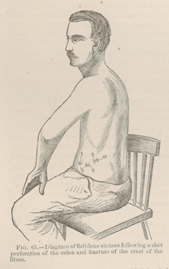Title: Graham, Thomas H.
Source text: The Medical and Surgical History of the War of the Rebellion. (1861-65.), Part 2, Volume 2 (Washington, DC: Government Printing Office, 1876), 96.
Civil War Washington ID: med.d2e31654
TEI/XML: med.d2e31654.xml
CASE 291.—Private Thomas H. Graham, Co. G, 1st Michigan, aged 18 years, was shot through the abdomen, at Bull Run, August 30, 1862, and was placed in an ambulance and sent to Washington, and admitted to Judiciary Square Hospital on the following day. There was but slight hæmorrhage, and the shock and depression were less intense than is commonly observed in penetrating shot wounds of the abdomen. Surgeon J. H. Brinton, U. S. V., saw the patient, and took much interest in the case, making notes of its principal features, and a diagram. Pension Examiner R. C. Hutton, also, has made several extended reports of this case, which Dr. A. L. Lowell, of the Pension Bureau, has politely transcribed and transmitted to this office. Dr. Brinton described the wound as inflicted "by a conoidal musket ball, which entered near the lower boundary of the left lumbar region, at a point about six inches to the left of the mesial line of the abdomen, and, passing backward and a little obliquely downward, made its exit about two and a half inches to the left of the spinal column, injuring the crest of the ilium in its course." Dr. Brinton further states that, "after a few days, a fæcal discharge occurred from both the openings, and continued until October 25th, when it ceased. The colon only was wounded. October 31st, nearly well; slight discharge of pus from the entrance wound, but no fæcal matter; exit wound closed." The hospital records show that Graham was discharged from service June 6, 1863, and pensioned. Several reports from pension examiners are on file, but the latest, by Dr. R. C. Hutton, of Howell, Michigan, covers the whole ground. After rehearsing the facts above related, Dr. Hutton continues: "The crest of the ilium was fractured, and probably considerably shattered, as the subsequent involvement of a considerable portion of the ilium, in a carious condition, indicates. The original wounds are indicated, on the diagram hereto attached, by the numerals 1, 2, both of which remain open ulcers. Subsequently ulcers became established in the order designated by the letters a, b, and c, on the diagram. The points of interest are that a probe may be passed through the original sinus, from 1 to 2, or from 1 to a, there being but a slight septum intervening between the two last-designated openings. A second probe, introduced at b or c, will readily intersect the first any where along its middle third. There is but a slight septum interposing between the openings b and c. From each of these sinuses there is constantly escaping an unhealthy sanious discharge, together with the fæcal contents of the bowels. Occasionally kernels of corn, apple seeds, and other indigestible articles have passed through the stomach and been ejected through these several sinuses. He is of healthy stock, and is a broad-shouldered, deep-chested, capacious stomached, powerful looking organization, and, before he was thus wounded, ordinarily weighed 185 pounds. Now he bears a sallow, sickly countenance, cannot stand erect, his left side being shortest. The left hip joint has become partially anchylosed, lateral motion of left leg being entirely destroyed. He can elevate the knee but three or four inches, and is, consequently, quite lame, and frequently unable to move about, The discharges from these wounds make him extremely offensive to society, under the most favorable appliances at his command. He would have died long ago from utter detestation of his condition, were it not for his indomitable pluck and patriotism. I have been intimately acquainted with him before and since his return from the war, and know that the condition of his disability has been constantly growing worse, and that for the past four or five years he has generally needed the attendance and aid of some person to assist him in dressing his wounds daily. I regard his case as utterly hopeless of relief." This report is dated March 6, 1872.


